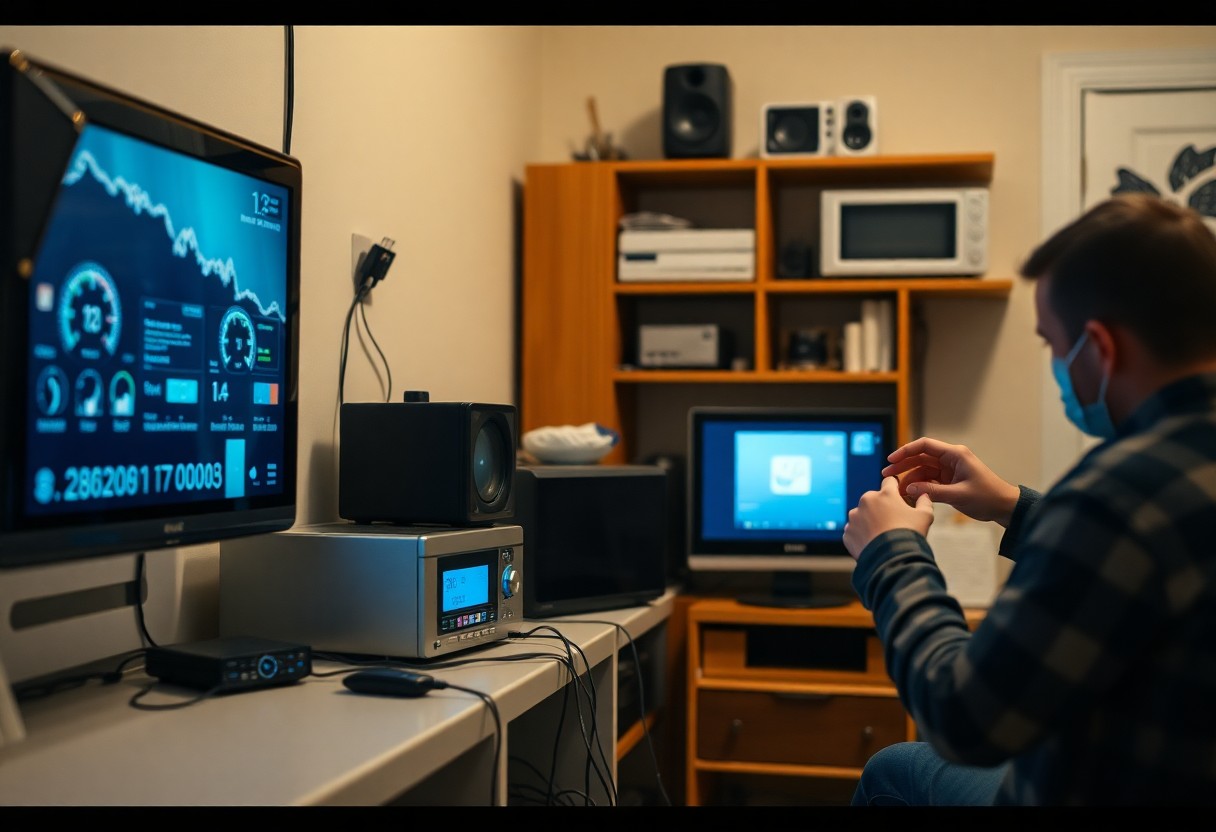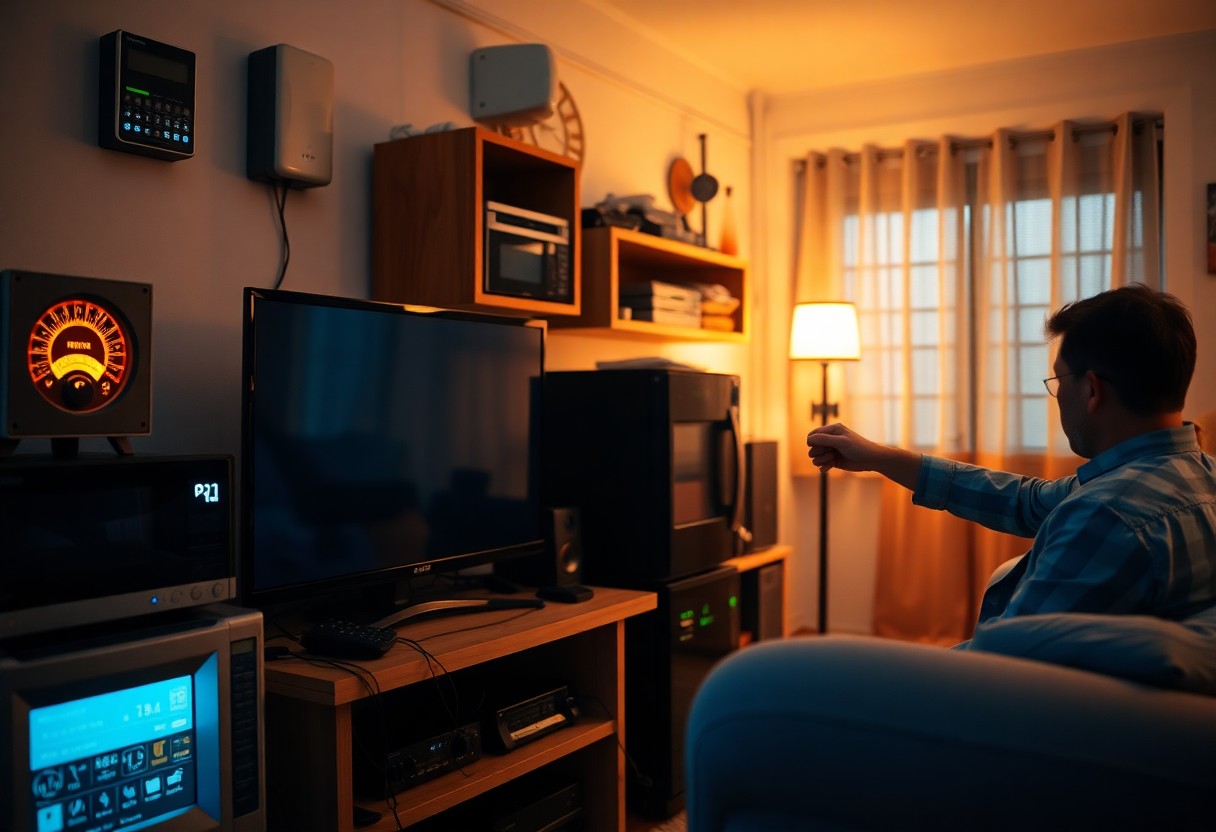There’s a good chance you’re unaware of how many devices in your home continue to consume electricity even when they’re switched off. In this guide, you’ll learn how to identify those sneaky energy-wasters and take steps to eliminate them, ultimately lowering your electricity bills and reducing your carbon footprint. For more insights on energy-saving tips, check out What Should I Unplug To Save Electricity?. Let’s get started on making your home more energy-efficient!
1. Identify all devices plugged into outlets in your home.
2. Check for devices with indicator lights or clocks.
3. Use a power meter to measure energy usage.
4. Unplug devices that consume power when off.
5. Consider using smart power strips to cut off power.
6. Schedule regular checks to maintain energy efficiency habits.
Understanding the Types of Energy-Wasting Devices
While it’s imperative to be aware of devices that waste electricity, knowing the types can make it easier to tackle. Here are some common culprits:
- Old appliances
- Chargers left plugged in
- Standby gadgets
- Home entertainment systems
- Smart home devices
Any of these can contribute to increased energy bills and unnecessary electricity usage.
| Device Type | Example |
| Kitchen Appliances | Microwaves, refrigerators |
| Bathroom Devices | Electric razors, hair dryers |
| Heating Devices | Space heaters, electric blankets |
| Entertainment | TVs, gaming consoles |
| Computing | Laptops, desktop computers |
Common Household Appliances
Clearly, common household appliances are often the main offenders when it comes to energy waste. Devices like old refrigerators or microwaves can consume energy even when not in active use. Check the age and efficiency rating of your appliances to understand their energy demands better.
Electronics and Gadgets
EnergyWasting gadgets, such as game consoles and smart speakers, can be sneaky when it comes to using electricity. Even when they’re turned off, many electronics continue to draw power, known as phantom load.
With so many electronics in our homes, it’s easy to overlook their energy consumption. Items like chargers, gaming systems, and computers can keep pulling energy even when not in use. Consider unplugging or using smart power strips to avoid these energy leaks. Making a simple habit of unplugging devices can make a notable difference in your energy bills while contributing to a more sustainable home.

Factors Contributing to Electrical Waste
Some common factors that lead to electrical waste can often go unnoticed in your home. These include:
- Devices left plugged in
- Equipment in standby mode
- Poorly maintained appliances
- Outdated technology
Knowing these factors can help you identify areas where you can save energy and reduce your electricity bill.
Standby Power Consumption
While you may think your devices are off, many of them continue to draw power in standby mode. This hidden energy use can accumulate, contributing to higher energy bills without you even noticing. Tackling standby power is a simple yet effective way to reduce waste.
Aging and Inefficient Devices
There’s a chance that your older appliances are using more energy than necessary. Over time, devices can lose efficiency, making them power guzzlers. It’s a good idea to regularly evaluate the efficiency of your gadgets.
Electrical devices that are aging may suffer from wear and tear, leading to decreased performance and increased energy consumption. You can often find newer models that utilize advanced technology to improve efficiency. By swapping out older appliances for energy-efficient counterparts, you not only cut down on your electricity usage but also benefit from modern features and reliability.
Step-by-Step Guide to Identifying Energy Wasters
After you’ve decided to tackle the energy-wasting culprits in your home, you need to systematically identify them. Below is a simple guide to help you track down these sneaky devices.
| Action | Details |
|---|---|
| List All Devices | Make a comprehensive list of all electronic devices in your home. |
| Check Power Ratings | Look for power ratings on each device to understand their energy consumption. |
| Use an Energy Meter | Plug an energy meter into outlets to check actual usage of devices. |
| Observe Usage Patterns | Take note of which devices remain plugged in even when not in use. |
Conducting an Energy Audit
On your journey to find energy wasters, conducting a thorough energy audit is a practical first step. This means assessing your home’s energy use, identifying the devices you frequently use, and pinpointing which devices might still draw power when they’re turned off. By mapping your energy usage, you’ll better understand where the biggest savings can be made.
Utilizing Smart Plugs and Meters
Even simple tools like smart plugs and meters can greatly simplify the process of tracking your energy usage. These devices allow you to monitor and control the power consumption of each appliance, even when you are away from home.
The beauty of smart plugs lies in their convenience; they not only measure how much energy your devices consume but can also schedule when devices turn on or off based on your preferences. This means you can eliminate phantom energy use entirely by controlling devices remotely or automatically. By integrating smart technology into your energy management, you empower yourself to take greater control over your electricity consumption and keep your bills in check.
Tips for Reducing Energy Waste
To cut down on unnecessary energy waste, you can adopt simple yet effective strategies:
- Unplug devices when not in use
- Use power strips for easy disconnection
- Consider investing in smart plugs
- Set a timer for outdoor lighting
- Regularly check for energy-efficient settings or upgrades
Perceiving these small changes can make a big impact on your energy bills.
Best Practices for Device Management
Energy efficiency starts with proactive device management. Regularly assess and unplug devices that are infrequently used, and invest in energy-efficient models when you upgrade. Keeping a checklist of your devices can help in tracking which ones need attention, ensuring you’re minimizing those phantom loads when the devices are powered off.
Educating Household Members
Any effort to reduce energy waste is most effective when everyone is on board and informed. Engaging your family members in discussions about the importance of energy conservation can cultivate a collective sense of responsibility.
Household cooperation can significantly amplify your energy-saving efforts. Consider organizing family meetings where you discuss energy-saving habits and even set goals together. Educating everyone about the impact of energy waste, such as turning off lights when leaving a room or unplugging chargers, can reinforce a sustainable lifestyle. Encourage questions and share insights to keep the enthusiasm alive, creating a more energy-conscious home environment.

Pros and Cons of Energy-Saving Devices
Not all energy-saving devices are created equal, so it’s wise to weigh their pros and cons before making a purchase. Here’s a quick breakdown to help you make an informed decision:
| Pros | Cons |
|---|---|
| Can reduce energy bills significantly | Initial costs can be high |
| Environmentally friendly | May require specific outlets or installations |
| Low maintenance | Some devices might not be compatible with older equipment |
| Easy to install and use | Performance may vary by brand |
| Increases energy efficiency | May cause inconvenience in specific usage |
Benefits of Upgrading
While exploring energy-saving devices, you may find that upgrading to newer technology not only boosts your energy efficiency but also enhances your overall home convenience. Modern devices often come with smart features, enabling you to control and monitor energy usage from your smartphone. They can help you pinpoint energy waste and optimize your consumption habits, ultimately leading to savings on your utility bills.
Potential Drawbacks
The appeal of energy-saving devices is undeniable; however, you should also be aware of the potential drawbacks. Some devices can have an initial high cost, which might not yield immediate savings. Compatibility issues with older systems and varying performance levels among different brands can also lead to frustration.
Understanding the potential drawbacks is imperative for a well-rounded decision. You might encounter products that do not fit your existing setups, requiring additional modifications or purchases. Moreover, while the energy savings can be significant, the upfront investment may take time to recover, which can leave you feeling hesitant about your choices. It’s all about finding the right balance and ensuring that your investment truly meets your needs.
Strategies for Eliminating Energy Waste
For a more energy-efficient home, you can start by reviewing devices that consume electricity even when they’re not actively in use. You can find guidance for tackling these hidden energy consumers by checking out the Home Idle Load Self-Diagnosis and Action Guide (PDF). This resource will help you identify and take action against energy waste in your space.
Smart Shopping for Energy-Efficient Devices
Smart purchasing decisions can significantly cut your energy bill. Look for ENERGY STAR-rated appliances and electronics that meet strict efficiency guidelines, which can save you money in the long run. Investing in energy-efficient devices means you’re not only helping the environment but also reducing unnecessary energy expenses.
Implementing Energy-saving Habits
Habits you adopt at home can greatly influence your energy consumption. Simple actions such as unplugging chargers when they’re not in use or employing smart power strips can make a big difference. By taking small steps, you contribute to a more sustainable lifestyle.
With consistent energy-saving habits, you can reduce your household’s electricity consumption significantly. Try establishing rules like turning off lights when leaving a room, utilizing natural light whenever possible, and being mindful of energy-intensive devices. These small yet impactful changes can lead to substantial savings on your energy bills while fostering a more eco-friendly home.
Summing up
So, by following this step-by-step guide, you can easily identify and eliminate devices that waste electricity when off, ultimately lowering your energy bill and being kinder to the planet. Check out this helpful resource on How to Kill Phantom Loads to gain even more insight. By being proactive, you can create a more energy-efficient home and enjoy the benefits that come with it!



